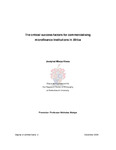| dc.description.abstract | Uncertainty of continued donor funding poses a risk to microfinance operations worldwide, and this
study explores the circumstances under which African microfinance institutions (MFIs) will consider
commercial funding as a viable alternative source of funding. This research aims to identify the
factors that are associated with successful access to private capital for pro-poor financial
institutions. It examines the suitability of new opportunities for accessing fresh capital by MFIs for
development and poverty reduction using commercialisation as an option. In a world awash in
private capital, it is vital to harness the power of the private sector to solve key development
challenges (World Bank, 2007). As microfinance institutions grow, they increasingly find
themselves in need of additional capital to finance expansion of services to cover more poor
communities.
The study undertook a cross-country data analysis of 103 microfinance institutions to help provide
understanding of the critical success factors that underpin successful access to commercial capital.
The study also tested the hypothesis on the viability of commercial finances, and developed and
tested a commercialisation success model for tapping commercial funds. The prediction model
based on firm-level data from a sample of 21 African countries between 1998 and 2003, aims to
minimise chances of failure and act as a screening system by investors as well as a selfassessment tool for MFIs intending to seek commercial capital. On examining the direct and
indirect impact of firm-level success factors on commercialisation, the study identified key
predictors of success and guidelines for MFI financing’s integration with the larger financial system.
The study finds that certain critical success factors (CSFs) define minimum pre-conditions for
microfinance institutions considering commercial funding as an alternative source of finance. There
is evidence to suggest that the desire to tap into the capital markets and capacity to link with
commercial investors is a realisable vision for African MFIs. The research evidence is instructive of
widened financing options for MFIs and capacity to relax growth constraint in the industry. Based
on the CSFs, the study suggests how MFIs can break free from 'captive' donor funding as a
necessary platform for the switch to commercial finance in the industry. However, the findings also
suggest the need for MFIs to satisfy the interests and requirements of prospective commercial
investors to overcome new challenges.
In particular, the results show that the extent of organisational formalisation and transparency in
financial reporting are absolutely essential in drawing commercial lenders to invest in microfinance.
In addition the study establishes the reasons why traditional approaches to financing microfinance
cannot work any longer. There are some concerns on mission drift; in particular whether the poor
gain from commercialisation, and under what circumstances their interests are taken care of in
order to preserve the long-term social value of microfinance as a poverty reduction strategy.
vi
The study was carried out based on a rather limited time series data. However, the number of firms
and the diversity is considered adequate for the study, as well as sample representation across
Africa. The study also used views of 'thought leaders' as the source of information. Other
personnel calibre may have had different suggestions. Perceptions were drawn from commercial
lenders/investors of microfinance programmes based in Africa. Needless to say, any generalisation
of CSFs beyond the African microfinance context should be made with caution.
This study is probably one of the first attempts to explore the possibility of a linkage between
microfinance and capital markets and it will be of interest to MFIs, commercial banks, international
donors and investment funds with an interest in investing in the microfinance industry. The findings
suggest that the speed of increase in financial leverage per country depends as much on the
dynamism of the market, as it does on the level of development of the finance sector. The results
indicate that commercial investors will be attracted by good financial returns and administrative
efficiency (return on assets, cash-flow adequacy and operating expense ratio), transparent
reporting and information disclosure and clarity, as well as low inflation levels. Investors will also be
looking for larger, regulated and profitable MFIs with a low-risk profile for their investment
portfolios.
The study found strong support to the hypothesis that the commercialisation index (CI) is a better
measure of successful commercialisation than the LMA (leverage multiplier added), given the
variables used. In all cases, compelling evidence shows that the CI has more explanatory power
and is an accurate predictor of two-year success in commercialisation as examined by logistic
regression. These results suggest that the superior predictive abilities of the CI commercial rating
rule could be explored to guide screening efforts for winners, investment decisions and other
binary classification investigations. Specifically, the model can be useful in guiding successful
commercialisation schemes in Africa because it provides MFIs with a structured approach for
achieving sustainable commercial microfinance. | en_US |

